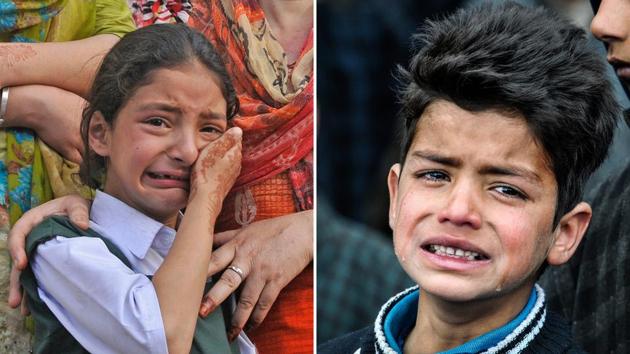Political differences should not get in the way of our empathy for the grief of children
Zohra’s and Burhan’s photos are the two sides of the same coin. The two innocent children cried because they lost someone dear to the decades-old conflict and their images became definitive of the Valley’s crisis. Those responsible for the deaths, however, belonged to the opposite halves of the ongoing war in Kashmir.
At noon on Monday, an assistant sub-inspector of Jammu & Kashmir police Abdul Rashid Shah was gunned down by militants in the south Kashmir town of Anantnag. At the wreath-laying ceremony held for Shah at the district police lines in Srinagar in the evening, his five-year-old daughter Zohra broke down uncontrollably into tears. Press photographers captured that heart-wrenching moment – Zohra, dressed in her school uniform, sobbing as if there were no tomorrow without her father.

Zohra’s photos went viral by Tuesday morning – official social media handles of the J&K police tweeted the image and a Facebook page of the deputy inspector general of police, south Kashmir range, wrote a message that every drop of Zohra’s tears seared the heart of every policeman.
As a journalist based in Srinagar for the last two years, I have regularly come across ghastly photographs of bullet-riddled and mutilated bodies of militants or security personnel, mothers and sisters of civilian protesters and militants crying at funerals and young faces perforated by pellets. And yet, Zohra’s photo was an image most disturbing – a picture capable of haunting you for a long time to come.
But Zohra’s photo brought to mind something else, too. In March, a similar image had gone viral – it was of a boy wailing at the funeral of at the funeral of a teenager killed during an encounter in Padgampora of Pulwama in south Kashmir.
Amir Nazir, a student of Class 9, died after being hit by a bullet in the neck when forces allegedly opened fire to quell protesters who had gathered at the site of the gun-battle to save the trapped militants. His family says he was ‘targeted’ while the police say a ‘stray bullet’ was responsible.
I travelled to a village called Begumbagh in Pulwama district to trace the boy in the photograph and find out his story – who was he, how was he associated to the slain teenager and why was he crying. I met nine-year-old Burhan Fayaz at Amir’s house and he broke down while telling me, “Amir sirf neighbour nahi, woh mera bhaai tha” (Amir was not only a neighbour but like a brother to me).
Outside the house, I met a few other teenaged boys and asked them would they again venture out to save trapped militants, now that Amir was killed. “Hum phir jayenge (we will go again),” came the sharp response.
Zohra’s and Burhan’s photos are the two sides of the same coin. The two innocent children cried because they lost someone dear to the decades-old conflict and their images became definitive of the Valley’s crisis. The men with guns responsible for the deaths, however, belonged to the opposite halves of the ongoing war in Kashmir.
But empathy for Zohra and Burhan won’t come from the same quarters in the Kashmir conflict. The outrage follows a selective path, it’s either black or white: Zohra’s photograph was shared mostly and her plight lamented by those who stand firmly on the state’s side in the Kashmir narrative while Burhan’s photo was made viral, not by official handles of the state, but by people who are vocal in questioning the state’s role in the strife-torn Valley. The other side, in each case, is mostly silent.
Photographs like these two should be empathised with unequivocally irrespective of which political narrative they tend to further – because how the sufferings of children like Zohra and Burhan are healed will define what course the conflict takes on from here.
Abhishek Saha is HT’s Srinagar correspondent. He tweets as @saha_abhi1990





